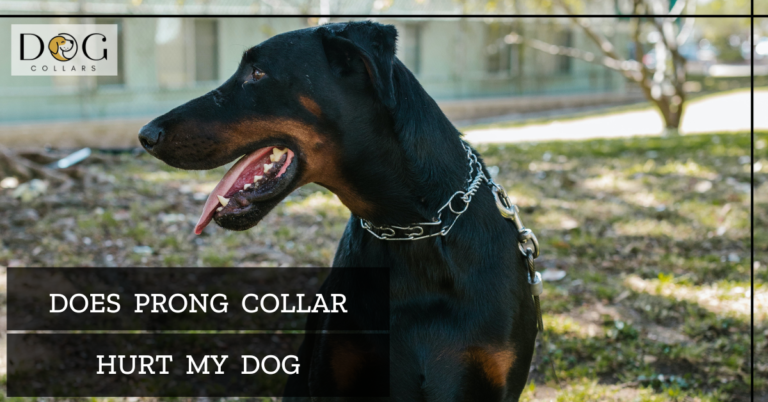Is Shock Collar Bad for Dogs – Expert Analysis & Advice

Hey, fellow dog owners! Have you ever considered using a shock collar to train your furry best friend? Well, let me tell you, it’s not necessarily a bad thing when used correctly and responsibly! These collars have adjustable intensity, give fast results, and are affordable.
Using dog shock collars is a controversial topic. Many argue that it is cruel and can have long-term negative effects on the dog’s behavior and well-being. Studies have shown that the use of e-collars can lead to psychological disorders. It can also damage the bond and trust between the dog and its owner.
It is important to consider alternative dog training techniques that prioritize reward-based training and the humane treatment of animals.
Is shock collar bad for dogs? As responsible pet owners, It’s important to weigh the pros and cons before deciding on this disputed training method. Let’s dive into it.
Is Using a Shock Collar Bad for Dogs? Exploring the Benefits
Shock collars can be effective tools for training dogs to obey commands and avoid dangerous behaviors. Using these on a dog can be controversial. Here are some potential pros of shock collars for dogs:
1. Adjustable Intensity
As a dog owner, I’ve found that one of the best things about using an adjustable e-collar is that you can customize the intensity to fit your pup’s needs. Whether you have a small, sensitive dog or a large, stubborn one, you can find the perfect level for your furry friend by starting low and increasing gradually.
For instance, I discovered that my small dog only needed a low-intensity setting to get the message, while my friend’s bigger dog required a stronger jolt to respond.
And the best part? By controlling the intensity, you can train your pet safely without harming them. So if you’re looking for a training tool that gives you flexibility and control, while keeping your dog safe and happy, then an adjustable intensity of collar could be just what you need!
2. Fast Results
When it comes to training my dog, I want to see results as soon as possible. That’s why I love using an e-collar – it’s super effective and delivers fast results. Unlike traditional learning styles that can take forever to work, shock collars can also produce noticeable changes in just a session or two.
The sensation from the collar immediately gets my dog’s attention, and I’ve found that it’s great for reinforcing good behaviors and discouraging bad ones. But of course, every dog is different, so it’s important to be patient and not rush the training process.
In the end, deciding whether or not to use a static collar is a personal choice. But if you want to see fast results in your dog’s behavior and are willing to put in the work, then a shock collar could be a great tool to add to your training arsenal!
3. Affordable
As a dog owner, I’m always looking for ways to train my furry friend without breaking the bank. That’s why I love using an e-collar – it’s affordable and effective! Unlike hiring a pro trainer or going to obedience classes, these collars won’t cost you an arm and a leg.
Plus, a good-quality electric collar can actually save you money in the long run. You won’t need to buy expensive tools like clickers, leashes, or treats. It’s a win-win!
I also appreciate that e-collars are affordable for more people, regardless of their budget. So even if you’re on a tight budget, you can still ensure your pup is well-behaved and disciplined.
Of course, cost shouldn’t be your only consideration when choosing training tools for your dog. Do your research and find the best option that works for your specific needs and preferences. But if you’re looking for an affordable and effective way to train your furry friend, then an e-collar could be a great choice!
4. Can be Used at a Distance:
Static collars coupled with an electric fencing system are designed to function even when you are not around.
Plus, you can use them from a distance. However, it’s important to keep in mind that shock training should only be used in certain situations and with proper training techniques. Our top priority should always be our dog’s safety and well-being.
So, before using an e-collar, do your research and consult with a professional trainer or veterinarian for guidance. Let’s train our dogs the right way!
Ultimately, the decision whether or not to use shock collars and electric fences on your pet should be made after careful consideration of all options. It’s important to seek advice from a professional dog instructor before using this type of device. Always prioritize your pet’s well-being over quick fixes or shortcuts in their training process.
5 Reasons Why Shock Collars for Your Dog Are Bad
Shock collars can cause dogs physical distress and other problems, that’s why it is a highly debated topic amongst pet owners and animal welfare advocates. While some may argue that they are an effective way to train dogs, there are many reasons why e-collars are considered bad for your furry friend. Here are 5 reasons why you should avoid using these:
1. They can cause physical harm
Electronic collars are designed to deliver an electric shock to your dog when they misbehave. The level of shock can range from mild to severe, and the device can even cause burn marks or skin irritations. This can lead to physical harm and trauma for your pet.
2. They can worsen behavior
Shock collars may cause your pet to become more anxious or aggressive, leading to even worse behavior. This can create a vicious cycle where your dog becomes increasingly disobedient and stressed.
3. They are based on punishment
Training with e-collars relies on punishment rather than positive reinforcement, which can be damaging to your pet’s well-being. Reinforcing good behavior, such as treats and praise, has been shown to be more effective in training dogs and will help build a stronger bond between you and your furry friend.
4. They can be misused
It can be easy to misuse shock collars, even accidentally. If the device is not set up correctly or if it is used irresponsibly. It can give your dog unnecessary pain and distress
5. There are better alternatives
There are many alternative coaching methods that are less harmful and can be just as effective, such as clicker training or reward-based training. These methods rely on reward-based training and are better for your dog’s physical and mental well-being.
Overall, shock collars for your dog should be avoided due to the many negative consequences they can have on your pet’s health and behavior. Instead, opt for reward-based teaching methods to create a happy and healthy relationship between you and your furry friend.
Alternatives to Shock Collars
There are plenty of effective alternatives to using a dog training collar that delivers electric shocks on your dog.
- Reward-based training methods, such as treats and rewards, focus on rewarding good behavior instead of punishing bad behavior.
- Vibration collars can be an alternative to shock collars, emitting a gentle vibration as a way to get a dog’s attention without causing harm.
- Ultrasonic devices emit high-pitched sounds that only dogs can hear when they bark excessively, which can help deter barking without causing physical discomfort.
- Professional dog trainers who specialize in reward-based training techniques can provide one-on-one guidance for effective training without resorting to punishment or negative reinforcement.
- Interactive toys and puzzle games can help train dogs while providing mental stimulation and engagement.
- Training sessions should be kept short and frequent, focusing on reinforcing good behavior to build a strong bond between the owner and the dog.
- Consistency and patience are key to successful training, and owners should prioritize their dog’s safety and well-being by avoiding harmful training methods.
It’s important to remember that shock collars aren’t the only way to train your dog effectively. By exploring different methods based on encouraging behavior and seeking out professional guidance, you can find what works best for both you and your furry friend.
Conclusion
After exploring the benefits and drawbacks of using a collar on dogs, it is clear that there are more negative effects than positive ones. While these devices can be effective in stopping unwanted behaviors, they come with potential risks such as physical harm to the dog and increased aggression.
As responsible pet owners, we should prioritize our furry friends’ safety and well-being. Instead of resorting to painful shock collars or other aversive training methods, consider positive reinforcement techniques like treats, praise, and playtime to train your dog.
Additionally, consulting with a professional dog trainer can provide valuable insights into how to effectively address any behavioral issues without causing harm.
FAQs
Why You Should Not Use a Bark Collar on Your Dog?
It can lead to anxiety, fear, and aggression. These collars use static shocks to train dogs, which is inhumane and cruel. There are other humane methods to train dogs, such as positive reinforcement training. The use of shock collar on your dog is not only unethical but also illegal in some countries.
Are shock collars cruel to dogs?
There is a lot of debate about whether the collars are cruel to dogs. Some people argue that they are a quick and effective way to train your dog, while others believe that they can be cruel and cause unnecessary pain and suffering.
Do professional dog trainers use shock collars?
E-collars should only be used as a last resort by professional dog trainers. Positive reinforcement and clicker training are ethical and effective alternatives that are becoming more widely accepted.
What can I use instead of a shock collar?
here are better ways to train your dog than the use of shock collars. Use positive reinforcement, like treats and praise, or a vibrating collar or leash instead. Always train with patience and care, not fear or punishment.
At what age can a dog wear a shock collar?
Wait until your dog is at least six months old, has basic obedience training, and uses an e-collar only as a last option after trying other behavior modification methods.
How do Shock Collars Work?
Shock collars are a training device used to stop barking of dogs. They are worn around the neck of the dog and have a contact point that delivers a mild electric shock to create a negative reinforcement. Collars can also have different features like beeping or vibration to assist in training.
Are prong collars bad for dogs?
Many dog owners and trainers believe that prong collars are bad for dogs due to the potential harm they can cause to a dog’s neck and throat. These dog collars rely on spikes or prongs to apply pressure, which can lead to discomfort, pain, and even injury.
How does dog spray collars work?
Dog spray collars work by emitting a burst of citronella or another unpleasant scent when the dog barks excessively. This serves as a deterrent to the undesired behavior, as the dog will associate the unpleasant scent with barking.
What type of collar is best for a strong dog?
A martingale collar or a slip collar can be a good option to help prevent the dog from slipping out of the collar and to provide better control. However, it’s important to note that bark collars are not recommended for any type of dog behavior.






